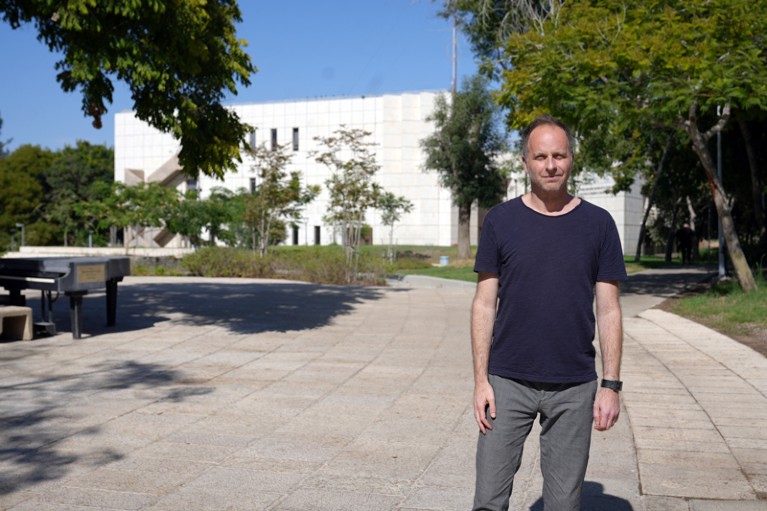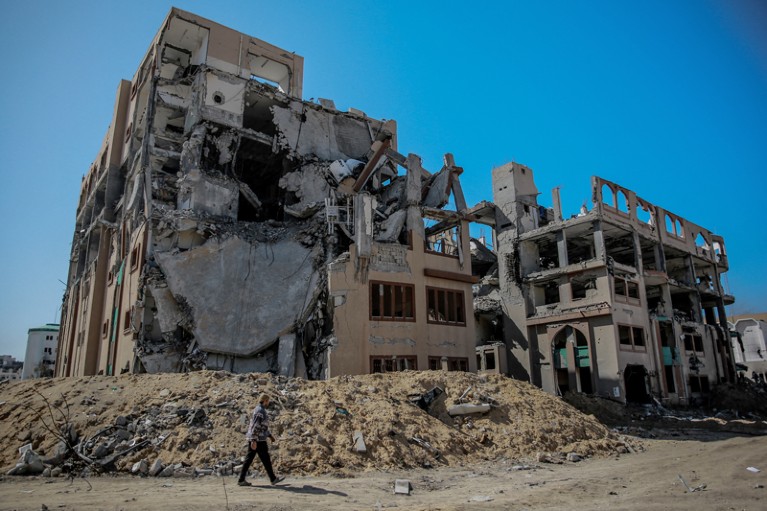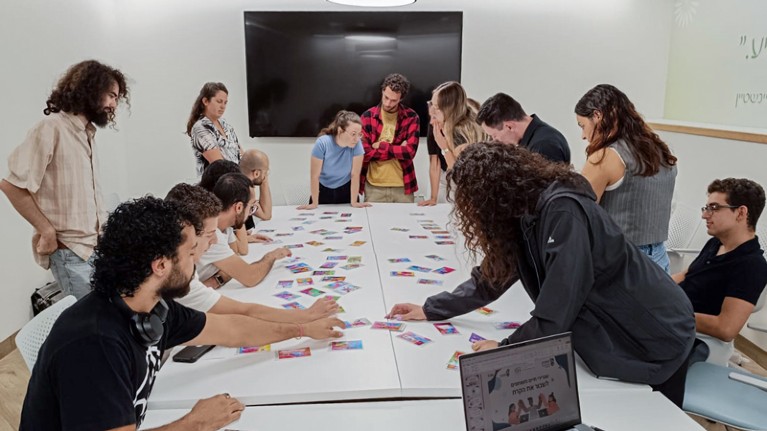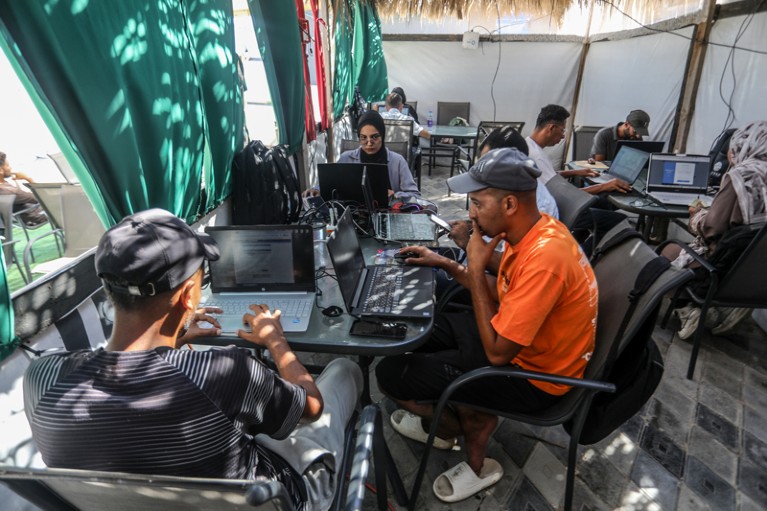Scientists, tech entrepreneurs and educators on both sides of the border describe the devastation of lost homes, destroyed laboratories and slain colleagues.
07 October 2024. By Josie Glausiusz
Hussein Al-Ajrami, who ran his own biotechnology company in Gaza City, relocated to Cairo in early May, fleeing the Israeli bombardment of the Gaza Strip that began after the brutal terrorist attacks on Israel by Hamas on 7 October 2023. He left behind his wife, four daughters and parents, who are now living in tents in Al-Mawasi, on the southern coast of Gaza.
“I had a house, a car, a factory, I had a job,” says Al-Ajrami. “I had my own company, I was teaching at universities and working as a consultant for local community non-governmental organizations.” Now, in the wake of the ongoing war, Al-Ajrami says, “my house is completely destroyed. My car is destroyed. My factory is destroyed. We walked out with just our clothes on.”
But the devastation hasn’t stopped Al-Ajrami from working as a consultant for Damour for Community Development, a Palestinian non-profit organization in Gaza that is partnering with the Arava Institute For Environmental Studies, an educational institution and peace-building initiative in Ketura, Israel. As part of Jumpstarting Hope in Gaza, an Israeli–Palestinian initiative launched by the two organizations in June, Al-Ajrami is helping to design and build “small, sustainable shelters” for displaced Palestinians in Al-Mawasi and Khan Yunis in southern Gaza.
The first shelter, which accommodates 700 families living in separate tents, was established in Al-Mawasi in February. A second shelter in Al-Mawasi “has a small capacity to produce electricity via solar panels and to desalinate some water” and treat waste water, says David Lehrer, director of the Center for Applied Environmental Diplomacy at the Arava Institute, which allows residents to “maintain cleanliness and safety and to provide communal services such as a central kitchen, laundry, toilets and showers”.

The Arava Institute has partnered with Damour to provide enough solar panels, batteries, desalination equipment and wastewater treatment to serve all the needs of the displaced people, Lehrer adds. They are awaiting approval from the Israeli army to bring equipment into Gaza.
In Egypt, Al-Ajrami is searching for international partners and sources for shelter materials that are difficult to locate in Gaza. “Unfortunately, I could not bring my family — my wife, children, father, mother, sister, brother — all of them are still in Gaza,” he says, noting that his family has been displaced more than eight times during this war. On 7 May, the Israel Defense Forces took control of the Rafah border crossing between Gaza and Egypt, and the crossing has since been closed.
Al-Ajrami is one of thousands of Palestinian researchers, scientists and students from Gaza who are attempting to restart their lives and careers — in Gaza or elsewhere — in the wake of the devastating war, in which more than 41,000 Palestinians have been reported killed, according to the Ministry of Health – Gaza and the United Nations Office for the Coordination of Humanitarian Affairs. An estimated 70,000 housing units have been destroyed. During the 7 October attacks, 1,200 Israelis were killed and 250 were abducted by Hamas, some of whom were later killed in captivity. Researchers in the region face formidable obstacles to rebuilding their careers: destruction of their homes, bombed infrastructure, cancelled work contracts and, for Palestinians, forced relocations and the lack of electricity, health care, water and sanitation.
All 19 universities and community colleges in Gaza have been destroyed or damaged. UN observers are concerned that the systematic destruction of universities in Gaza — as well as damage or destruction of 80% of its primary and secondary schools — constitutes ‘scholasticide’, defined as the systemic obliteration of education.
Even those who can leave Gaza face an uphill struggle to regroup, having lost their livelihood and savings. But amid war and devastation, researchers, educators and entrepreneurs are determined to find a way forward. Nature spoke with scientists in Gaza and their counterparts in Israel and the West Bank Palestinian territory, who refuse to lose hope. Using salvaged solar panels, mobile phones and working spaces in tents, scientists participate in remote learning and research collaboration through Zoom, continuing to carry on even when their universities and workspaces no longer exist.
Leaving his family behind in Gaza while he pursued his sustainability-consulting work, Al-Ajrami says, was “a very difficult feeling”.
“All the time, I’m thinking about them, but what can I do?”
Supporting traumatized students
On the other side of the Israel–Gaza border, university life has been upended as well. Sapir College — located just 3.5 kilometres from Gaza, on the outskirts of Sderot, a town in southern Israel — was closed after the towns of Sderot and Ofakim were attacked and burnt by Hamas on 7 October. Many students had lived in dormitories in the 19 collective villages, or kibbutzim, that were largely destroyed, says Omri Herzog, Sapir College’s rector.
“The first week after 7 October, I was operating like a robot,” recalls Herzog, who teaches cultural studies and literature at Sapir. He and his colleagues contacted all 8,000 Sapir students and 900 faculty members to check on their safety. They discovered that 34 Sapir students, staff and alumni had been killed, and that two people connected with Sapir had been abducted by Hamas, one of whom was later killed. The other remains captive. Some 1,500 students and staff from the surrounding communities fled from their burnt homes “with nothing, only their clothes”, says Herzog. In late December, the college reopened for only administrative staff, he says. More than a year later, Sapir students are just now returning full-time to campus for the new academic year, which will start next month.

Nevertheless, the university has tried to give the students structure in the wake of the devastation, and has offered each of them 12 talk-therapy sessions. “The campus itself is beautiful, very green and peaceful,” says Herzog. At the same time, “you can hear, quite loudly, the Israeli bombings of Gaza, and you can sometimes smell the smell of war”, which he calls a “metallic sourness” of explosives residue.
After 7 October, Herzog says, the university recognized this as “a ‘grow or die’ moment for us”, and committed to expanding its offerings. Sapir plans to build a new health-sciences department and another for advanced technologies, including data science, engineering and agrotech. The Israeli government’s Tekuma Authority, which was set up to rehabilitate, invest in and develop the region adjacent to the Gaza Strip, will provide free tuition to Sapir College students and funds to rebuild the destroyed dormitories.
About 20% of Sapir’s students are Arab–Israeli, Herzog notes — most of them are from the local Bedouin community, and many have relatives in Gaza. Coexistence is part of the university’s ethos, he adds. “In this little corner of the world, where the tension is so high, you can find Jewish and Bedouin people, working together,” says Herzog.
Have laptop, will code
Another example of resilience in the face of war’s atrocities is the software engineers in Gaza who continue to scout for remote assignments amid the destruction of telecommunications infrastructure and intermittent Internet access. “Online digital work remains one of the few viable opportunities for sustainable and inclusive economic growth in Palestine,” says Alan El-Kadhi, director of Gaza Sky Geeks (GSG), a programme of Mercy Corps, a non-governmental aid organization headquartered in Portland, Oregon.
“The purpose of GSG is to help build an inclusive, prosperous and resilient economy in Palestine,” El-Kadhi says. Before the war, the GSG offered a coding academy for university graduates in Gaza and the West Bank – the largest Palestinian territory, which is divided into three areas that are under either Israeli, Palestinian or joint control. The GSG also ran a training programme to help participants launch their own start-up companies. El-Kadhi, who is based in Ramallah in the West Bank, explains that the organization had already trained more than 20,000 young Palestinians in Gaza and the West Bank in professional skills such as coding, cloud computing and data analytics, so that they could earn money online. Many of them are now working from tents.

Before the war, Gaza was becoming recognized internationally as a place to hire high-quality coders, graphic designers and translators for online content, he says. Since 7 October, however, “the situation in Gaza is so severe, it’s beyond words. People are just struggling to survive the destruction, the bombs, disease, the famine, living in tents.”
All three of the GSG’s offices in Gaza have been destroyed, and the organization has paused its tech-training programmes there, says El-Kadhi; it is now focusing on expanding its activities in the West Bank and helping tech companies there to reach new international markets.
“But what’s quite inspiring is that many of these individuals have managed to keep their laptops,” even while fleeing destruction and relocating to tent encampments, El-Kadhi says. “They all want to generate income, because they are desperate for money.” The GSG community has already created several pop-up co-working spaces in tents in Gaza, he adds.
Shaden Tubaileh, the communications and public-relations coordinator at the GSG, agrees that graduates in Gaza are keen to get back to work. She reports that Birzeit University in Ramallah in the West Bank has opened its online courses to Palestinians in Gaza. “The moment they opened the registration, most classes were filled by Gazan students” attending remotely, she says. “They are eager to get back to their lives, to their work, to their studies.”
“As a programme of Mercy Corps, we have to be optimistic — we’re all waiting for a ceasefire,” says El-Kadhi. “The moment that happens, we will re-activate Gaza Sky Geeks programmes again.”
Defusing tensions
In northern Israel, an ongoing conflict with the militant group Hezbollah has intensified in the past few weeks, with Israel launching attacks against Hezbollah in Lebanon and Hezbollah firing back. It has led to the mass evacuation of communities on both sides of the Israel–Lebanon border. This has placed the city of Haifa, Israel, some 40 kilometres away, at increased risk of missile attacks. The Technion – Israel Institute of Technology in Haifa lost two students and numerous family members of students and staff on 7 October and in the ongoing war, says Ayelet Fishman, dean of students at Technion.
About 28% of Technion’s students are Arab–Israeli, Fishman says, adding that there has been little conflict between Arab and Jewish students at the Technion: most are focused on their studies in science and engineering.
Nevertheless, she says, the university was concerned about potential tensions on campus. So, they hired a non-profit organization — aChord, based in Jerusalem — which promotes tolerance and respect among Israel’s social groups, to prepare staff before the academic year. The organization uses a traffic-light model for dialogue that distinguishes between “violent, racist and threatening speech” (red), “disrespectful speech” (yellow) and “democratic conversation” (green) and encouraged staff to intervene in cases of unacceptable language in classroom or hallway discussions.
Further, Fishman says, in May the university started a programme to build community on campus, in which students from different groups share their perspectives and participate in activities together, such as talking about holidays, traditions, cultural views and food. Arabic-speaking students also teach the language to their peers as part of the programme. “We’re aiming to help the students get some sense of belonging to the Technion,” she says, even amid the traumatizing events and disruption.

In the West Bank, the pursuit of science and technology studies is also very challenging, says Mona Nabil Demaidi, dean of digital sciences at the Arab American University in Jenin in the West Bank. A computer scientist, Nabil Demaidi also directs STEMpire, a technology company founded in 2020 that is dedicated to nurturing the artificial-intelligence ecosystem in Palestine.
STEMpire conducts three-day hackathons, as well as bootcamp training programmes, in which tech graduates connect with mentors in the private sector and work on real-world problems. Last year, Demaidi also conducted a Climate Thinkathon, in which 30 students in Gaza and the West Bank came up with strategies for climate action and to improve drinking-water quality.
Even before 7 October, she says, about 70% of her classes at An-Najah National University in Nablus in the West Bank, where she taught previously, were held online. Since the war began, students coming from outside Nablus have to wait, on average, 2–3 hours at Israeli checkpoints to reach the campus. “That’s if they’re lucky,” Demaidi says. Palestinian students in the West Bank face the risk of raids on campus by the Israeli Defense Forces, which happened in January at An-Najah, she adds. “It was not safe for us or the students.”
Cross-border collaboration
Before the war and at its outset, many students in Gaza had uploaded their university transcripts and essential documents, such as copies of their passports and birth certificates, to Internet-based cloud services, says J., an environmental scientist at a research university in Israel, who has worked closely with colleagues in Gaza. In fact, he recommends that every researcher save crucial data in this way. (J. asked to remain anonymous to protect his Palestinian contacts.)
J. has helped Mohammed, a master’s student in engineering in Gaza, to raise money through GoFundMe to leave the region with his extended family. Mohammed, who asked to be identified by his first name for safety reasons, had been studying at Al-Azhar University — Gaza before it was destroyed. Before the war, the two researchers had collaborated on projects to map sources of electronic waste and pollution in Gaza. After 7 October, they began mapping airborne pollution in Gaza, sampling six or seven sites at which chemicals had been stored, apartments burnt or concrete buildings pulverized.
“I gave him training via Zoom on open-source geographic information system software that I use,” J. says. Mohammed carried a solar panel from his damaged home to charge his phone to communicate. Their Internet connection was very slow. J. describes their long, technical sessions as an eerie experience in which the two avoided speaking about their strange circumstances, because they did not know how long their Internet connection would last. From time to time, Mohammed apologized for the sounds of bombing.
Mohammed and his wife, together with their infant daughter, have moved homes eight times, most recently to Deir al-Balah in central Gaza. “Whenever we settle, we have to evacuate, which is, long story short, so much pain,” Mohammed says. With the help of friends and donors, Mohammed has now raised more than US$95,000 to pay the steep fees for crossing into Egypt, as well as related costs, with his extended family. However, on the day he reached his fundraising goal in May, Israeli forces closed the border with Egypt at Rafah.
“I cannot leave, and I cannot find a safe place to live in. It’s so scary,” Mohammed says. Even so, he and his wife, who is also a master’s student in engineering, are now doing online courses in machine learning. “We are still hoping that the border will open so that we can move on with our lives,” he says.
J. is trying to help Mohammed and his wife get into doctoral programmes in the United Kingdom, the United States or Italy, although he knows this will contribute to brain drain from Gaza. However, he says, “my primary allegiance is to them, as people”.
“The loss of talent enrages and saddens me so much,” J. says. “I know what these kids would [accomplish] if there were different circumstances”, nodding to their excellent transcripts and CVs and admiring their perseverance against the odds.
That kind of strength in the face of adversity is typical for Gazans, says Demaidi. Despite the loss of lives and the almost unimaginable level of destruction, she insists “there is a future” for academia in Gaza once the war stops. “I’ve worked with the young generation in the West Bank and Gaza. Gazans are super-resilient. They come up with solutions faster than anyone else I’ve ever known. And they really want to live.”
Nature 634, 501-503 (2024)
doi: https://doi.org/10.1038/d41586-024-03263-y
